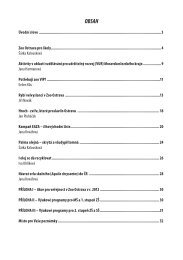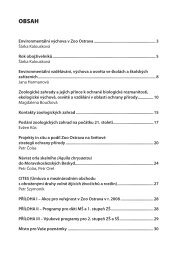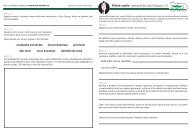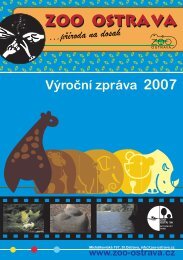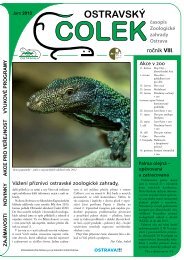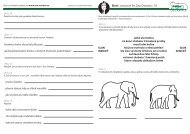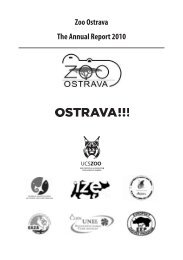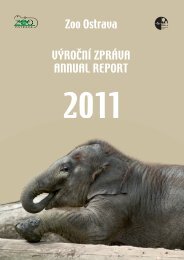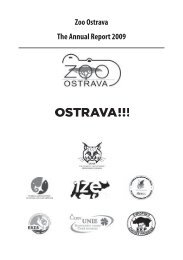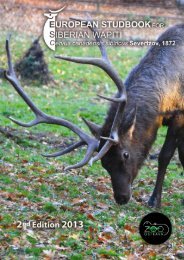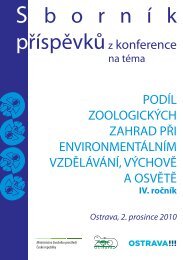together with another bearded vulture of the same age bred at a conservation centre in the departmentof Upper Savoy. In most cases, two young birds are put in nests, although only a single chick is reared in thebearded vulture, where cainism is quite common, as the young birds feel less abandoned, motivate each otherand stay together some time even upon they leave the nest. The juveniles are fed, monitored and tracked onsuch place, but in other aspects, they are left as they are. After some fourteen days, the young birds fix suchplace as their own nest and imprint on the surrounding area as their new home. Once the birds leave the nest,they still get additional feeding from humans for several months, but subsequently are able to find their ownfood. Condamine first flied out of the nest on 25 June when she was 116 days old; the flight took 10 secondsand the bird flied away upon having stayed 21 days in the park, getting adapted to its new habitat. It had to beforced to fly out by interrupting the on-the-nest feeding regime; following six days of non-feeding period, thebird flied off the nest to search for food. To conclude, the release technique above consists in takingusually two different juveniles from their parental nests before they leave the nest, placing thebirds jointly on a temporary nest in the native range of the species.The young cinereous vulture was transported into the territory of Verdon canyon and released into thepre-release aviary together with another young vulture bred at Bochum <strong>Zoo</strong>. As with the bearded vultures,the birds were fed and monitored, getting familiar with their new settings. As they were undergoing thepre-release process, they imprinted on their new home. In the Verdon canyon region, there is a promisingpopulation of the griffon vulture, as well as a new cinereous vulture stock, the latter now reinforced by the<strong>Ostrava</strong>'s young bird. However, all the birds have survived there only with support of conservationists whoprovide feeding to the vultures on a permanent basis. On the other hand, this has worked well in terms ofsocialisation of the newly released birds from the very start - the young ones can watch numerous freerangingvultures fed at a close distance from the aviary even prior the release as while bearded vultures areterritorial birds in their nesting season, cinereous vulture lead semi-colonial and the griffon vultures evencolonial life. Both cinereous vultures were released from the aviary on 18 October <strong>2009</strong>, i.e. after having spentover a month there, getting familiar to each other and undergoing the pre-release period. In this case, therelease technique consists in taking usually multiple different juveniles from their parents onlyafter the young have left the nest, placing the birds jointly in a pre-release aviary and releasingthe birds from this aviary after an adaptation period.Once the birds have flown out, they continue to be monitored. To make it possible, each bird is carefullyringed and microchipped to provide for identification from close; in addition, specific flight or tail feathersare bleached, which is very well visible from below when the bird is flying. Implanted transmitters work alsovery well, as they allow for receiving signals from a distance of many kilometres, plus transmitters are nowultralight and miniature devices posing no restraints on the bird.In its consequences, this success of <strong>Ostrava</strong> <strong>Zoo</strong> in terms of breeding as well as management was anextraordinary event for the country and entire cultural world, as it was a clear example of the fact that ifman stops preventing nature to exist normally and human faults from the past have been redressed, wildlifeand habitats recover locally and continue to be natural and cultural heritage for our children and futuregenerations. And may it be that our children's approach will be more friendly than that of their parents andgrandparents. Let us believe that zoological parks will be amongst the ones to take a lead.52
Monitoring nests of endangered birds of prey speciesJana PluháčkováThe cinereous vulture (Aegypius monachus), the griffon vulture (Gyps fulvus) and the bearded vulture(Gypaetus barbatus) - all these three birds of prey species are endangered in the wild and included in Europeanconservation breeding programmes (EEP) and European Studbooks (ESB). For the cinereous vulture, <strong>Ostrava</strong><strong>Zoo</strong> is even one of two breeders throughout Europe that successfully produced offspring of this species over thelast year. The offspring was released into the wild in the territory of the French Alps within the reintroductionscheme coordinated by the European Endangered Species Breeding Programme (EEP). Similarly, a young birdof another species - the bearded vulture - was released from <strong>Ostrava</strong> <strong>Zoo</strong> into the wild in Europe in <strong>2009</strong>.Although both rearing events were finished with success and without complications, the zoo personnel hadto inspect each of the nests several times, checking if everything runs smoothly. However, any such checkposes some risks - the parents may get frightened, break the egg, trample the chick or refuse to get back tothe nest.Considering this, the zoo decided to acquire a CCTV system to allow nest monitoring in the species above bythe personnel without having to disturb the birds alone. As those systems are not very cheap, an applicationfor funding was submitted to the Czech Ministry of Environment and subsequently satisfied, so the zoo couldbuy and install three cameras in <strong>2009</strong>, one per species.Each device is placed out of reach of the birds above the nest and records every movement in theneighbourhood of the nest. All data are stored in a computer and evaluated. The systems provide keeperswith a good overview in that they can check if the birds have already laid the egg and incubate it properly orhow often they take turn in sitting on the nest; in rare cases, they can even see the young one hatch - shortly,they can check everything that could be earlier only estimated from the distance upon the birds' behaviour.Nonetheless, this is not all what CCTV systems can do for bird breeding; indeed, they enable the personnelwatching if the hatched chick is fed properly and prospers or not. If the latter is true and the parental care ispoor, the young one can be taken away in time or even hand-raised where necessary.Thanks to the systems purchased through the MoE grant, the zoo can now monitor nesting behaviour usinga non-invasive technique, which is going to have positive effects on the reproductive success in the threespecies of endangered birds of prey in <strong>Ostrava</strong>, whilst leading to ultimate sustaining and boosting ex situand in situ populations owing to the intense cooperation with other European zoos, which may representa significant contribution to conservation of those ecologically important species.53
- Page 2 and 3:
Provozovatel zoo: Zoologická zahra
- Page 5 and 6:
ObsahÚvodní slovo ředitelePetr
- Page 7 and 8:
Vážení příznivci Zoo Ostrava,d
- Page 9 and 10:
Stavy chovaných zvířatChov zví
- Page 12 and 13:
pečovaly o mláďata z roku předc
- Page 15 and 16:
2) z účelově vázaného přísp
- Page 17 and 18:
Rok 2009 byl pro naši organizaci v
- Page 19 and 20:
Výnosy v roce 2009v tis.Kč% změn
- Page 21 and 22:
Osobní náklady tj. vlastní mzdy,
- Page 23 and 24:
Výstavba, projektová činnost a
- Page 25 and 26:
Z dalších změn v areálu zoo sto
- Page 27 and 28:
• byla dokončena projektová př
- Page 29 and 30:
Vzdělávací a propagační činno
- Page 31 and 32:
• 25.7. Když si zvířata hrají
- Page 33 and 34:
Činnost dendrologického oddělen
- Page 35 and 36:
Pozorování a sběr údajů o zví
- Page 37 and 38:
Rok šelem v Zoo OstravaMonika Ondr
- Page 39 and 40:
Historický nárůst počtu chovan
- Page 41 and 42:
Chov nového druhu primáta v Zoo O
- Page 43 and 44:
akovinným bujením, které zapří
- Page 45 and 46:
Odchov supa hnědého v Zoo Ostrava
- Page 47 and 48:
Repatriace supa hnědého a orlosup
- Page 49 and 50:
ještě před vylétnutím a jejich
- Page 51 and 52:
Odchov ohrožených druhů papoušk
- Page 53 and 54:
tuto budku přijali. Opět si vytvo
- Page 55 and 56:
pobývali většinou venku, mládě
- Page 57 and 58:
Novinky u slonůPavel ZvolánekRok
- Page 59 and 60:
při průchodu porodními cestami,
- Page 61 and 62:
Róze se poslední mládě narodilo
- Page 63 and 64:
Návrat orla skalního (Aquila chry
- Page 65 and 66:
Seznam zaměstnanců Zoo Ostrava (k
- Page 67 and 68:
Jméno Funkce Počet let v org.62 P
- Page 69 and 70:
Druh (poddruh)Species (subspecies)S
- Page 71 and 72:
Druh (poddruh)Species (subspecies)S
- Page 73 and 74:
Druh (poddruh)Species (subspecies)S
- Page 75 and 76:
Druh (poddruh)Species (subspecies)S
- Page 77 and 78:
Druh (poddruh)Species (subspecies)S
- Page 79 and 80:
Druh (poddruh)Species (subspecies)S
- Page 81 and 82:
Druh (poddruh)Species (subspecies)S
- Page 83 and 84:
Druh (poddruh)Species (subspecies)S
- Page 85 and 86:
Druh (poddruh)Species (subspecies)S
- Page 87 and 88:
Druh (poddruh)Species (subspecies)S
- Page 89 and 90:
Druh (poddruh)Species (subspecies)S
- Page 91 and 92:
Druh (poddruh)Species (subspecies)M
- Page 93 and 94:
FormaFormazajícovci (Lagomorpha)St
- Page 95 and 96:
▲ Nejvzácnější přírůstek r
- Page 97 and 98:
▲ Úprava vnitřních prostor v p
- Page 99 and 100:
▲ Odběr spermatu u samce slona i
- Page 101 and 102:
◀ Nový druh v Zoo Ostrava - peli
- Page 103 and 104:
▶ Pohlednice u voliéry supů hn
- Page 105 and 106:
◀ Google v zoo při sběru datpro
- Page 108 and 109:
Zoological Garden OstravaAddress: Z
- Page 111 and 112: ContentsDirector´s introductory wo
- Page 113 and 114: Dear friends,Ostrava Zoo is coming
- Page 115 and 116: Animal numbersAnimal collection in
- Page 117 and 118: of which a member of the very rare
- Page 119 and 120: success refers to the offspring pro
- Page 121 and 122: The founder’s non-capital funding
- Page 123 and 124: 3) CZK 737 thousand allocated to re
- Page 125 and 126: To co-fund 46.4% from the operating
- Page 127 and 128: As regards cost items in 2009, only
- Page 129 and 130: namely tiger enclosures, hoofed mam
- Page 131 and 132: Design, development and maintenance
- Page 133 and 134: This operation was supported by the
- Page 135 and 136: • Development of the building app
- Page 137 and 138: Ostrava Zoo - the zoo office and ma
- Page 139 and 140: Again, the event was co-funded by t
- Page 141 and 142: and involved models of a turtle she
- Page 143 and 144: Activities of the Horticulture Depa
- Page 145 and 146: and it was carried out by the scien
- Page 147 and 148: A year of carnivores at Ostrava Zoo
- Page 149 and 150: Historical increase in the number o
- Page 151 and 152: Keeping a new primate species at Os
- Page 153 and 154: for the lemurs, where the family of
- Page 155 and 156: Month 8 Beira's climbing the ropes
- Page 157 and 158: as the birds changed over on 28 Apr
- Page 159: • Birds of prey are rather slow i
- Page 163 and 164: The yellow cardinal at Ostrava ZooY
- Page 165 and 166: a bowl with fresh water multiple ti
- Page 167 and 168: it was found that one egg was impre
- Page 169 and 170: eginnings when the young are fed by
- Page 171 and 172: The way the bull was handled within
- Page 173 and 174: Keeping the common hippopotamus (Hi
- Page 175 and 176: Studbook # /nameSexDate ofbirthDam/
- Page 177 and 178: General summaryThanks to the projec
- Page 179 and 180: NamePositionNumber of yearsin the o



